





Pollen bees? These are the native North American bees that were responsible for all of the pollination before the Europeans brought honey bees to the New World. There are over 3,500 species of pollen bees in North America alone.
There is much concern today over the plight of the honey bee and 'Colony Collapse Disorder' or CCD. '[This] is the phenomenon in which worker bees from a beehive or European honey bee colony suddenly disappear.' [1] It is possible that many of you do not know that the honey bee is a European import to North America or that there are many native bees which do an excellent job of pollination and did so long before the honey bee was buzzing on these shores.
There are approximately 20,000 members of the order Hymenoptera worldwide; that is, bees and wasps that pollinate, not including Apis or honey bees. 'Hymenopterophily' is a term coined in 1992 to refer to pollination by any non-honey bee. There are many types of these bees with interesting names; leafcutter, sweat, bumble, fuzzylegs, wool carder, cuckoo, mason and mining, to name a smattering. Most of the names are derived from a particular characteristic or activity peculiar to that species. For more information, click on any of the highlighted names in the article and you will be taken to the appropriate page in BugFiles, the spider and insect identification database at Dave's Garden that keeps growing with help from gardeners like you.
Most everyone is familiar with the humble bumble bee or Bombus, pictured in the opening thumbnail. It is large and fuzzy and non-threatening. I have taken very close-up photographs seemingly without disturbing them at all, although they will sting if provoked. There are 44 native species with some of the more important being American (B. pensylvanicus), Franklin's (B. franklini), rusty patched (B. affinis), Sonoran (B. sonorus) and yellowbanded (B. terricola). They pollinate by sonication; '[t]he bee grabs onto a flower and moves its flight muscles rapidly to release the pollen. The bee's face is then covered in pollen, which is inadvertantly deposited on the next flower on which the bee forages.' [2] Bumble bees are able to fly in rainy, windy, cool and cloudy weather, unlike honey bees, which gives them an advantage. An interesting fact is that they are used in greenhouses because they don't fly against the windows as do honey bees. [3] The Common Eastern bumble bee (B. impatiens) is not solitary like some of the other pollination bees. They live in colonies of 200 or more engaging in many of the activities of human society; caring for offspring, gathering food, constructing and defending their homes. [4]
Some plants require sonication for pollination. Examples are tomatoes, strawberries, eggplants, peppers and blueberries. In fact, there is a specialist in the southeastern part of the United States that is active for a few weeks in the spring when the blueberries (Vaccinum spp.) are in bloom. The Southeastern blueberry bee, or Habropoda laboriosa, resembles a small bumble bee. It nests in the ground and produces only one generation per year. It is also an important pollinator of some native wildflowers including Carolina and swamp jessamine (Gelsemium sempervirens and G. rankinii), redbud (Cercis canadensis), thistle (Cirsium spp.) and lupine (Lupinus spp.). [2]
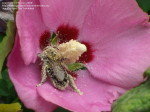 Not all of these native pollinators have characteristics that we favor. Carpenter bees (Xylocopa spp.) nest in wood by making perfectly round holes with their very strong mandibles. This can weaken whatever wooden structures they have chosen. They rarely choose painted wood. Resembling bumble bees, but without the hairy abdomen, they are also nectar robbers. If they cannot fit inside a flower, they will cut a hole in the base to get at the nectar and bypass the pollen altogether. [5] At left is pictured X. virginica, the Eastern carpenter bee, literally covered in pollen.
Not all of these native pollinators have characteristics that we favor. Carpenter bees (Xylocopa spp.) nest in wood by making perfectly round holes with their very strong mandibles. This can weaken whatever wooden structures they have chosen. They rarely choose painted wood. Resembling bumble bees, but without the hairy abdomen, they are also nectar robbers. If they cannot fit inside a flower, they will cut a hole in the base to get at the nectar and bypass the pollen altogether. [5] At left is pictured X. virginica, the Eastern carpenter bee, literally covered in pollen.
 Leafcutter bees (Megachile spp.) are used by humans for pollination much as honey bees are. The best known of these is M. rotundata (at right), the alfalfa leafcutter bee. The biggest difference is that leafcutters are solitary bees, living in single nests rather than colonies or hives. They are used for such crops as carrots, alfalfa, onions and blueberries. They are also known to visit the flowers of the aster and bean families and will pollinate peanuts in the early morning hours when it is most efficient, before honey bees are even active. [6]
Leafcutter bees (Megachile spp.) are used by humans for pollination much as honey bees are. The best known of these is M. rotundata (at right), the alfalfa leafcutter bee. The biggest difference is that leafcutters are solitary bees, living in single nests rather than colonies or hives. They are used for such crops as carrots, alfalfa, onions and blueberries. They are also known to visit the flowers of the aster and bean families and will pollinate peanuts in the early morning hours when it is most efficient, before honey bees are even active. [6]
Mason bees are another branch of the Megachile family. The orchard mason bee (Osmia lignaria) is particularly desireable for those who grow apples and cherries. The bees will nest in any cavities in wood but do no damage. They are shiny dark blue and slightly smaller than a honey bee. If you want to encourage this bee to stay in your orchard or yard to insure pollination of your fruit trees, there are trap nests readily available for purchase 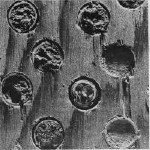 or you can easily make one by drilling holes 1/4-inch to 3/8-inch diameter and 3 to 6 inches deep in a pine or fir 4-by-4. The female bee lays her egg in the hole and carries in a supply of pollen to feed the larvae when it hatches. Then she seals it with a thin plug of mud. After the egg hatches and the larvae consumes the pollen, it spins a cocoon and waits for spring to start the cycle over again. [7]
or you can easily make one by drilling holes 1/4-inch to 3/8-inch diameter and 3 to 6 inches deep in a pine or fir 4-by-4. The female bee lays her egg in the hole and carries in a supply of pollen to feed the larvae when it hatches. Then she seals it with a thin plug of mud. After the egg hatches and the larvae consumes the pollen, it spins a cocoon and waits for spring to start the cycle over again. [7]
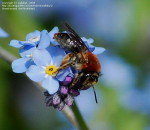 Mining bees are solitary bees, also known as miner, digger or sand bees because they live in the ground. They are medium-sized bees with hairy bodies and pollen baskets (corbicolae) on their hind legs, so they transport lots of pollen. Pictured at left is Andrena haemorrhoa, the early mining bee. They are pollinators of many of the previously mentioned crops and wildflowers. However, they also specialize in a small range of native plants including spotted coral-root (Corallorhiza maculata), small white lady's-slipper (Cypripedium candidum), yellow carpet (Blennosperma spp.), meadowfoam (Limnanthes spp.), goldfield (Lasthenia spp.) and skyblue (Downingia spp.). [8]
Mining bees are solitary bees, also known as miner, digger or sand bees because they live in the ground. They are medium-sized bees with hairy bodies and pollen baskets (corbicolae) on their hind legs, so they transport lots of pollen. Pictured at left is Andrena haemorrhoa, the early mining bee. They are pollinators of many of the previously mentioned crops and wildflowers. However, they also specialize in a small range of native plants including spotted coral-root (Corallorhiza maculata), small white lady's-slipper (Cypripedium candidum), yellow carpet (Blennosperma spp.), meadowfoam (Limnanthes spp.), goldfield (Lasthenia spp.) and skyblue (Downingia spp.). [8]
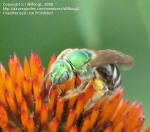
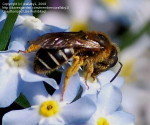 The last one for discussion pollinates many of the same plants listed above. They are generally solitary, although a few species may live in colonies (eusocial). Like the others, these bees engage in sonication, also called 'buzz pollination.' So why mention them at all? They are mostly black or brown (near right), although some do come in bright metallic green (far right) or brassy yellow. But what really sets halactid bees apart (Halactidae) is their other name; sweat bees. They have a habit of landing on people and licking their perspiration to obtain the salt. [9]
The last one for discussion pollinates many of the same plants listed above. They are generally solitary, although a few species may live in colonies (eusocial). Like the others, these bees engage in sonication, also called 'buzz pollination.' So why mention them at all? They are mostly black or brown (near right), although some do come in bright metallic green (far right) or brassy yellow. But what really sets halactid bees apart (Halactidae) is their other name; sweat bees. They have a habit of landing on people and licking their perspiration to obtain the salt. [9]
These are some of the major types of pollen bees, but there are many more. Please remember that they are out there working for us in our gardens. They are tireless workers. They are free. And they are organic. They bring you some wonderful fruits, beautiful colors, free seeds (that you won't get from an unpollinated blossom) and maybe even some happy hybrids that you weren't expecting. Welcome them to your garden. Don't be afraid of them. Most bees are fairly docile. It's the wasps and hornets that are aggressive. Do respect them and let them go about their work, especially if you have a bee allergy. And do your very best to keep pesticides out of your garden. Honey may be sweet, but there's nothing sweeter than what these wonderful creatures do for us.
Many thanks to the DG photographers who provided the excellent bee shots; onalee (opening thumbnail - bumble bee), Ibycus (Eastern carpenter bee), PanamonCreel (alfalfa leafcutter bee), wallaby1 (early mining bee & sweat bee [H. rubicundus]), Wilfong1 (sweat bee [A. virescens])
Mason bee trap nest photo courtesy of Washington State University Extension Library
[1] Colony Collapse Disorder; Wikipedia, the Free Encyclopedia, date of last revision 5 June 2009
[2] This Native Bee Loves Blueberries, Pollinators, National Biological Information Infrastructure
[3] Bumble Bees: Terrific Greenhouse Pollinators, Pollinators, National Biological Information Infrastructure
[4] Bumble Bee, PlanetNatural.com
[5] Carpenter Bees - Both Pollinators and Nectar Robbers, Pollinators, National Biological Information Infrastructure
[6] Leafcutter Bees, Pollinators, National Biological Information Infrastructure
[7] Orchard Mason Bees, Gardening in Western Washington, WSU Extension Library
[8] Mining Bees are Common Pollinators of Both Crops and Native Plants, Pollinators, National Biological Information Infrastructure
[9] Sweat Bees are Pollinators of Many North American Plants, Pollinators, National Biological Information Infrastructure
Copyright © www.100flowers.win Botanic Garden All Rights Reserved